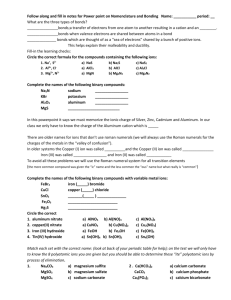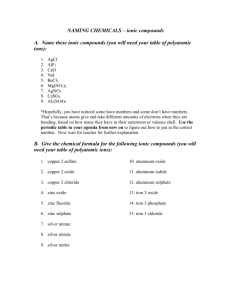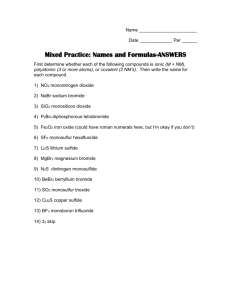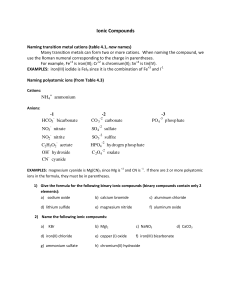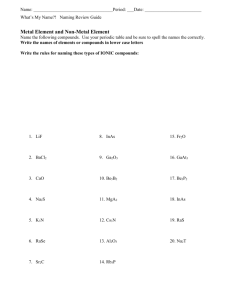Chapter 6 Nomenclature-Powerpoint Notes Part 2
advertisement
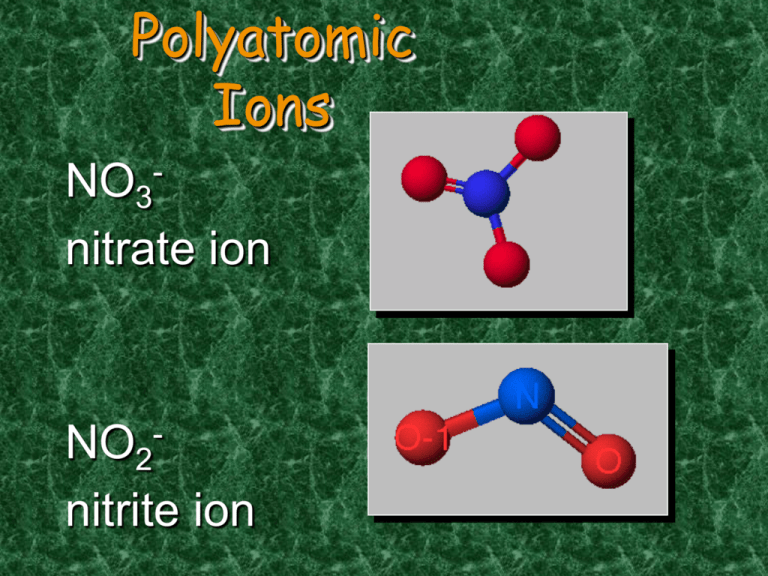
Polyatomic Ions - NO3 nitrate ion NO2nitrite ion Polyatomic Ions You can make additional polyatomic ions by adding a H+ to the ion! CO3 -2 is carbonate HCO3– is hydrogen carbonate H2PO4– is dihydrogen phosphate HSO4– is hydrogen sulfate Ternary Ionic Nomenclature Writing Formulas • Write each ion, cation first. Don’t show charges in the final formula. • Overall charge must equal zero. • If charges cancel, just write symbols. • If not, use subscripts to balance charges. • Use parentheses to show more than one of a particular polyatomic ion. • Use Roman numerals indicate the ion’s charge when needed (stock system) Ternary Ionic Nomenclature Sodium Sulfate Na+ and SO4 -2 Na2SO4 Iron (III) hydroxide Fe+3 and OHFe(OH)3 Ammonium carbonate NH4+ and CO3 –2 (NH4)2CO3 Learning Check 1. aluminum nitrate a) AlNO3 b) Al(NO)3 c) Al(NO3)3 2. copper(II) nitrate a) CuNO3 b) Cu(NO3)2 c) Cu2(NO3) 3. Iron (III) hydroxide a) FeOH b) Fe3OH c) Fe(OH)3 4. Tin(IV) hydroxide a) Sn(OH)4 b) Sn(OH)2 c) Sn4(OH) Naming Ternary Compounds Contains at least 3 elements There MUST be at least one polyatomic ion (it helps to circle the ions) Examples: NaNO3 Sodium nitrate K2SO4 Potassium sulfate Al(HCO3)3 Aluminum bicarbonate or Aluminum hydrogen carbonate Learning Check Match each set with the correct name: 1. Na2CO3 a) magnesium sulfite MgSO3 b) magnesium sulfate MgSO4 c) sodium carbonate 2. Ca(HCO3)2 CaCO3 a) calcium carbonate b) calcium phosphate Ca3(PO4)2 c) calcium bicarbonate Mixed Practice! Name the following: 1. Na2O 2. CaCO3 3. PbS2 4. Sn3N2 5. Cu3PO4 6. HgF2 Mixed Up… The Other Way Write the formula: 1. Copper (II) chlorate 2. Calcium nitride 3. Aluminum carbonate 4. Potassium bromide 5. Barium fluoride 6. Cesium hydroxide Naming Molecular Compounds CO2 Carbon dioxide CH4 methane BCl3 boron trichloride All are formed from two or more nonmetals. Ionic compounds generally involve a metal and nonmetal (NaCl) Molecular (Covalent) Nomenclature for two nonmetals • Prefix System (binary compounds) 1. Less electronegative atom comes first. 2. Add prefixes to indicate # of atoms. Omit mono- prefix on the FIRST element. Mono- is OPTIONAL on the SECOND element (in this class, it’s NOT optional!). 3. Change the ending of the second element to -ide. Molecular Nomenclature Prefixes PREFIX monoditritetrapentahexaheptaoctanonadeca- NUMBER 1 2 3 4 5 6 7 8 9 10 Molecular Nomenclature: Examples • CCl4 • carbon tetrachloride • N 2O • dinitrogen monoxide • SF6 • sulfur hexafluoride More Molecular Examples • arsenic trichloride • AsCl3 • dinitrogen pentoxide • N2O5 • tetraphosphorus decoxide • P4O10 Learning Check Fill in the blanks to complete the following names of covalent compounds. CO carbon ______oxide CO2 carbon _______________ PCl3 phosphorus _______chloride CCl4 carbon ________chloride N2O _____nitrogen _____oxide Learning Check 1. P2O5 a) phosphorus oxide b) phosphorus pentoxide c) diphosphorus pentoxide 2. Cl2O7 a) dichlorine heptoxide b) dichlorine oxide c) chlorine heptoxide 3. Cl2 a) chlorine b) dichlorine c) dichloride Overall strategy for naming chemical compounds. A flow chart for naming binary compounds. Mixed Review Name the following compounds: 1. CaO a) calcium oxide c) calcium (II) oxide 2. 3. SnCl4 a) tin tetrachloride c) tin(IV) chloride b) calcium(I) oxide b) tin(II) chloride N2O3 a) nitrogen oxide c) nitrogen trioxide b) dinitrogen trioxide Solution Name the following compounds: 1. CaO a) calcium oxide 2. SnCl4 c) tin(IV) chloride 3. N2O3 b) Dinitrogen trioxide Mixed Practice 1. 2. 3. 4. 5. 6. 7. 8. 9. Dinitrogen monoxide Potassium sulfide Copper (II) nitrate Dichlorine heptoxide Chromium (III) sulfate Iron (III) sulfite Calcium oxide Barium carbonate Iodine monochloride Mixed Practice 1. 2. 3. 4. 5. 6. 7. 8. 9. BaI2 P4S3 Ca(OH)2 FeCO3 Na2Cr2O7 I2O5 Cu(ClO4)2 CS2 B2Cl4 Acid Nomenclature • Acids • Compounds that form H+ in water. • Formulas usually begin with ‘H’. • In order to be an acid instead of a gas, binary acids must be aqueous (dissolved in water) • Ternary acids are ALL aqueous • Examples: • HCl (aq) – hydrochloric acid • HNO3 – nitric acid • H2SO4 – sulfuric acid Acid Nomenclature Review Anion Ending No Oxygen Acid Name -ide hydro-(stem)-ic acid -ate (stem)-ic acid -ite (stem)-ous acid w/Oxygen An easy way to remember which goes with which… “In the cafeteria, you ATE something ICky” Acid Nomenclature Flowchart ACIDS start with 'H' 2 elements 3 elements hydro- prefix -ic ending no hydro- prefix -ate ending becomes -ic ending -ite ending becomes -ous ending Acid Nomenclature • HBr (aq) • No oxygen, -ide hydrobromic acid carbonic acid sulfurous acid • H2CO3 • Has oxygen, -ate • H2SO3 • Has oxygen, -ite Acid Nomenclature • hydrofluoric acid • 2 elements H+ F- HF (aq) • sulfuric acid • 3 elements, -ic H+ SO42- H2SO4 • nitrous acid • 3 elements, -ous H+ NO2- HNO2 Name ‘Em! • HI (aq) • HCl • H2SO3 • HNO3 • HIO4 Write the Formula! • Hydrobromic acid • Nitrous acid • Carbonic acid • Phosphoric acid • Hydrotelluric acid Nomenclature Summary Flowchart Now it’s Study Time DONE Rainbow Matrix Game • Link on Chemistry Geek.com on Chemistry I page • http://chemistrygeek.com/rainbow Use [ ] to represent subscripts since you can’t enter subscripts into the computer So H2O would be H[2]O And Al2(SO4)3 would be Al[2](SO[4])[3] Additional Polyatomic Ions (you do not have to memorize these, but they are in the game!) Borate = BO3 -3 ; Silicate = SiO4 -4 ; Manganate = MnO4 -2 (permanganate is -1)


